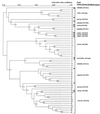Pneumococcal pspA sequence types of prevalent multiresistant pneumococcal strains in the United States and of internationally disseminated clones
- PMID: 11015380
- PMCID: PMC87453
- DOI: 10.1128/JCM.38.10.3663-3669.2000
Pneumococcal pspA sequence types of prevalent multiresistant pneumococcal strains in the United States and of internationally disseminated clones
Abstract
In a recent genotypic survey of beta-lactam-resistant pneumococci recovered in different areas of United States during 1997, eight clonal types that each represented 3 to 40 isolates accounted for 134 of 144 isolates (G. Gherardi, C. Whitney, R. Facklam, and B. Beall, J. Infect. Dis. 181:216-229, 2000). We determined the degree of pspA gene diversity among these 134 isolates and for 11 previously characterized internationally disseminated multiresistant strains. Thirty-four different pspA restriction profiles were determined for an amplicon encompassing the variable portion of the structural gene that encodes the surface-exposed domain of PspA and a variable-length proline-rich putative cell wall-associated domain. These restriction profiles closely correlated with those of 33 different pspA sequence types of an approximately 230-residue region corresponding to residues 182 to 410 of the strain Rx1 PspA. These residues encompass a 100-residue clade-defining region known to contain cross-protective epitopes for which 17 sequence types were found. Distinct, conserved pspA sequence types were found for the majority of strains within seven of the eight U.S. clonal types assessed, while one pulsed-field gel electrophoresis type was represented by isolates of three distinct PspA clades. Sequence typing of pspA provides an added level of specificity in the subtyping of isolates and is a necessary first step in determining the components needed in a PspA vaccine which could elicit effective cross-protective coverage.
Figures





References
-
- Briles D E, King J D, Gray M L, McDaniel L S, Swialto E, Benton K A. PspA, a protection-eliciting pneumococcal protein: immunogenicity of isolated native PspA in mice. Vaccine. 1996;14:858–867. - PubMed
-
- Briles D E, Tart R C, Wu H-Y, Ralph B A, Russell M W, McDaniel L S. Systemic and mucosal protective immunity to pneumococcal surface protein A. Ann N Y Acad Sci. 1996;797:118–126. - PubMed
-
- Briles D E, Hollingshead S, Swiatlo E, Dillard J P, Smith P, Benton K A, Ralph B A, Brooks-Walter A, Crain M J, Hollingshead S K, McDaniel L S. PspA and PspC: their potential for use as pneumococcal vaccines. Microb Drug Resist. 1997;3:401–408. - PubMed
-
- Coffey T J, Dowson C G, Daniels C G, Zhou M, Martin J, Spratt C, G. B, Musser J M. Horizontal transfer of multiple penicillin-binding protein genes, and capsular biosynthetic genes, in natural populations of Streptococcus pneumoniae. Mol Microbiol. 1991;5:2255–2260. - PubMed
-
- Coffey T J, Berron S, Daniels M, Garcia-Leoni M E, Cercenado E, Bouza E, Fenoll A, Spratt B G. Multiply antibiotic-resistant Streptococcus pneumoniae recovered from Spanish hospitals (1988–1994): novel major clones of serotypes 14, 19F and 15F. Microbiology. 1996;142:2747–2757. - PubMed
Publication types
MeSH terms
Substances
LinkOut - more resources
Full Text Sources
Other Literature Sources
Molecular Biology Databases

